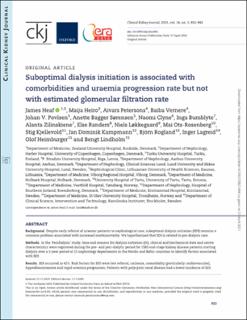| dc.contributor.author | Heaf, James | |
| dc.contributor.author | Heiro, Maija | |
| dc.contributor.author | Petersons, Aivars | |
| dc.contributor.author | Vernere, Baiba | |
| dc.contributor.author | Povlsen, Johan V. | |
| dc.contributor.author | Sørensen, Anette Bagger | |
| dc.contributor.author | Clyne, Naomi | |
| dc.contributor.author | Bumblyte, Inga | |
| dc.contributor.author | Zilinskiene, Alanta | |
| dc.contributor.author | Randers, Else | |
| dc.contributor.author | Løkkegaard, Niels | |
| dc.contributor.author | Ots-Rosenberg, Mai | |
| dc.contributor.author | Kjellevold, Stig Arne | |
| dc.contributor.author | Kampmann, Jan | |
| dc.contributor.author | Rogland, Björn | |
| dc.contributor.author | Lægreid, Inger Karin | |
| dc.contributor.author | Heimbürger, Olof | |
| dc.contributor.author | Lindholm, Bengt | |
| dc.date.accessioned | 2022-11-25T13:14:19Z | |
| dc.date.available | 2022-11-25T13:14:19Z | |
| dc.date.created | 2020-04-22T09:56:18Z | |
| dc.date.issued | 2020 | |
| dc.identifier.citation | Clinical Kidney Journal (CKJ). 2020, 14 (3), 933-942. | en_US |
| dc.identifier.issn | 2048-8505 | |
| dc.identifier.uri | https://hdl.handle.net/11250/3034132 | |
| dc.description.abstract | Background: Despite early referral of uraemic patients to nephrological care, suboptimal dialysis initiation (SDI) remains a common problem associated with increased morbimortality. We hypothesized that SDI is related to pre-dialysis care.
Methods: In the ‘Peridialysis’ study, time and reasons for dialysis initiation (DI), clinical and biochemical data and centre characteristics were registered during the pre- and peri-dialytic period for 1583 end-stage kidney disease patients starting dialysis over a 3-year period at 15 nephrology departments in the Nordic and Baltic countries to identify factors associated with SDI.
Results: SDI occurred in 42%. Risk factors for SDI were late referral, cachexia, comorbidity (particularly cardiovascular), hypoalbuminaemia and rapid uraemia progression. Patients with polycystic renal disease had a lower incidence of SDI. High urea and C-reactive protein levels, acidosis and other electrolyte disorders were markers of SDI, independently of estimated glomerular filtration rate (eGFR). SDI patients had higher eGFR than non-SDI patients during the pre-dialysis period, but lower eGFR at DI. eGFR as such did not predict SDI. Patients with comorbidities had higher eGFR at DI. Centre practice and policy did not associate with the incidence of SDI.
Conclusions: SDI occurred in 42% of all DIs. SDI was associated with hypoalbuminaemia, comorbidity and rate of eGFR loss, but not with the degree of renal failure as assessed by eGFR. | en_US |
| dc.language.iso | eng | en_US |
| dc.publisher | Oxford University Press | en_US |
| dc.rights | Navngivelse-Ikkekommersiell 4.0 Internasjonal | * |
| dc.rights.uri | http://creativecommons.org/licenses/by-nc/4.0/deed.no | * |
| dc.title | Suboptimal dialysis initiation is associated with comorbidities and uraemia progression rate but not with estimated glomerular filtration rate | en_US |
| dc.type | Peer reviewed | en_US |
| dc.type | Journal article | en_US |
| dc.description.version | publishedVersion | en_US |
| dc.source.pagenumber | 933-942 | en_US |
| dc.source.volume | 14 | en_US |
| dc.source.journal | Clinical Kidney Journal (CKJ) | en_US |
| dc.source.issue | 3 | en_US |
| dc.identifier.doi | 10.1093/ckj/sfaa041 | |
| dc.identifier.cristin | 1807469 | |
| cristin.ispublished | true | |
| cristin.fulltext | original | |
| cristin.qualitycode | 1 | |

